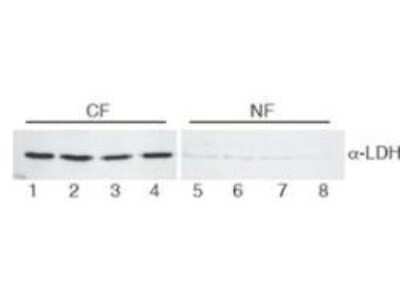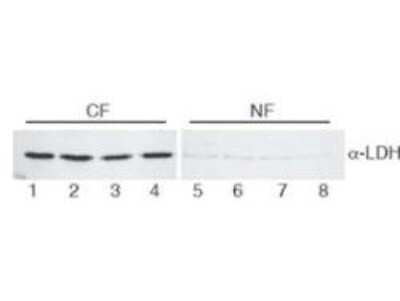Lactate Dehydrogenase Products
Lactate dehydrogenase is also known as L-lactate dehydrogenase A chain, LDHA, LDH muscle subunit and LDH-M. Two isozymes of LDH occur in mammals, LDH-M and LDH-H which come together to form a homotetramer of 36 kDa subunits. Every LDH molecule consists of four subunits, where each subunit is either H or M (based on their electrophoretic properties.) There are, therefore, five LDH isotypes: LDH-1 (4H) -in the heart, LDH-2 (3H1M) -in the reticuloendothelial system, LDH-3 (2H2M) -in the lungs, LDH-4 (1H3M) -in the kidneys and LDH-5 (4M) -in the liver and striated muscle. Usually LDH-2 is the predominant form in the serum. An LDH-1 level higher than the LDH-2 level (a "flipped pattern") suggests myocardial infarction (damage to heart tissues releases heart LDH, which is rich in LDH-1, into the bloodstream). In general, LDH is often used as a marker of tissue breakdown. LDH shows a cytoplasmic localization.
Show More
16 results for "Lactate Dehydrogenase" in Products
16 results for "Lactate Dehydrogenase" in Products
Lactate Dehydrogenase Products
Lactate dehydrogenase is also known as L-lactate dehydrogenase A chain, LDHA, LDH muscle subunit and LDH-M. Two isozymes of LDH occur in mammals, LDH-M and LDH-H which come together to form a homotetramer of 36 kDa subunits. Every LDH molecule consists of four subunits, where each subunit is either H or M (based on their electrophoretic properties.) There are, therefore, five LDH isotypes: LDH-1 (4H) -in the heart, LDH-2 (3H1M) -in the reticuloendothelial system, LDH-3 (2H2M) -in the lungs, LDH-4 (1H3M) -in the kidneys and LDH-5 (4M) -in the liver and striated muscle. Usually LDH-2 is the predominant form in the serum. An LDH-1 level higher than the LDH-2 level (a "flipped pattern") suggests myocardial infarction (damage to heart tissues releases heart LDH, which is rich in LDH-1, into the bloodstream). In general, LDH is often used as a marker of tissue breakdown. LDH shows a cytoplasmic localization.
Show More
| Applications: | Func |
Applications: WB, ELISA, ICC/IF, IP
Reactivity:
Human,
Rabbit
| Reactivity: | Human, Rabbit |
| Details: | Goat IgG Polyclonal |
| Applications: | WB, ELISA, ICC/IF, IP |
| Applications: | Func |
| Applications: | Func |
| Applications: | Func |
| Reactivity: | P. falciparum |
| Details: | Rabbit IgG Polyclonal |
| Applications: | ELISA |
| Reactivity: | Human, Mouse |
| Details: | Rabbit IgG Polyclonal |
| Applications: | WB, IP |
| Reactivity: | P. falciparum |
| Details: | Rabbit IgG Polyclonal |
| Applications: | ELISA |
| Reactivity: | P. falciparum |
| Details: | Rabbit IgG Polyclonal |
| Applications: | ELISA |
Applications: ELISA
Reactivity:
P. falciparum
| Reactivity: | P. falciparum |
| Details: | Rabbit IgG Polyclonal |
| Applications: | ELISA |
Applications: IHC, WB, ELISA, ICC/IF, IP, DB
Reactivity:
Human,
Rabbit
| Reactivity: | Human, Rabbit |
| Details: | Goat IgG Polyclonal |
| Applications: | IHC, WB, ELISA, ICC/IF, IP, +1 More |
Applications: IHC, WB, ELISA, ICC/IF, IP, DB
Reactivity:
Human,
Rabbit
| Reactivity: | Human, Rabbit |
| Details: | Goat IgG Polyclonal |
| Applications: | IHC, WB, ELISA, ICC/IF, IP, +1 More |
Applications: ELISA
Reactivity:
P. falciparum
| Reactivity: | P. falciparum |
| Details: | Rabbit IgG Polyclonal |
| Applications: | ELISA |
| Reactivity: | P. falciparum |
| Details: | Rabbit IgG Polyclonal |
| Applications: | ELISA |
| Reactivity: | P. falciparum |
| Details: | Rabbit IgG Polyclonal |
| Applications: | ELISA |
Applications: ELISA
Reactivity:
P. falciparum
| Reactivity: | P. falciparum |
| Details: | Rabbit IgG Polyclonal |
| Applications: | ELISA |

![Lactate Dehydrogenase Assay Kit (Colorimetric) [NBP3-24513] - Lactate Dehydrogenase Assay Kit (Colorimetric)](https://resources.bio-techne.com/images/products/nbp3-24513_lactate-dehydrogenase-assay-kit-colorimetric-8120241104527.png)
![Western Blot: Lactate Dehydrogenase Antibody [NB600-861] Western Blot: Lactate Dehydrogenase Antibody [NB600-861]](https://resources.bio-techne.com/images/products/Lactate-Dehydrogenase-Antibody-Western-Blot-NB600-861-img0012.jpg)
![Lactate Dehydrogenase Activity Assay Kit (Colorimetric) [NBP3-24512] - Lactate Dehydrogenase Activity Assay Kit (Colorimetric)](https://resources.bio-techne.com/images/products/nbp3-24512_lactate-dehydrogenase-activity-assay-kit-colorimetric-2611202315561411.png)
![Lactate Dehydrogenase Activity Assay Kit (Colorimetric) [NBP3-24510] - Lactate Dehydrogenase Activity Assay Kit (Colorimetric)](https://resources.bio-techne.com/images/products/nbp3-24510_lactate-dehydrogenase-activity-assay-kit-colorimetric-261120231556146.png)
![Lactate Dehydrogenase Activity Assay Kit (Colorimetric) [NBP3-24511] - Lactate Dehydrogenase Activity Assay Kit (Colorimetric)](https://resources.bio-techne.com/images/products/nbp3-24511_lactate-dehydrogenase-activity-assay-kit-colorimetric-2611202315565827.png)

![Immunoprecipitation:Lactate Dehydrogenase AntibodyNBP3-30578] - Lactate Dehydrogenase Antibody](https://resources.bio-techne.com/images/products/nbp3-30578_rabbit-lactate-dehydrogenase-pab-301220241740583.jpg)

